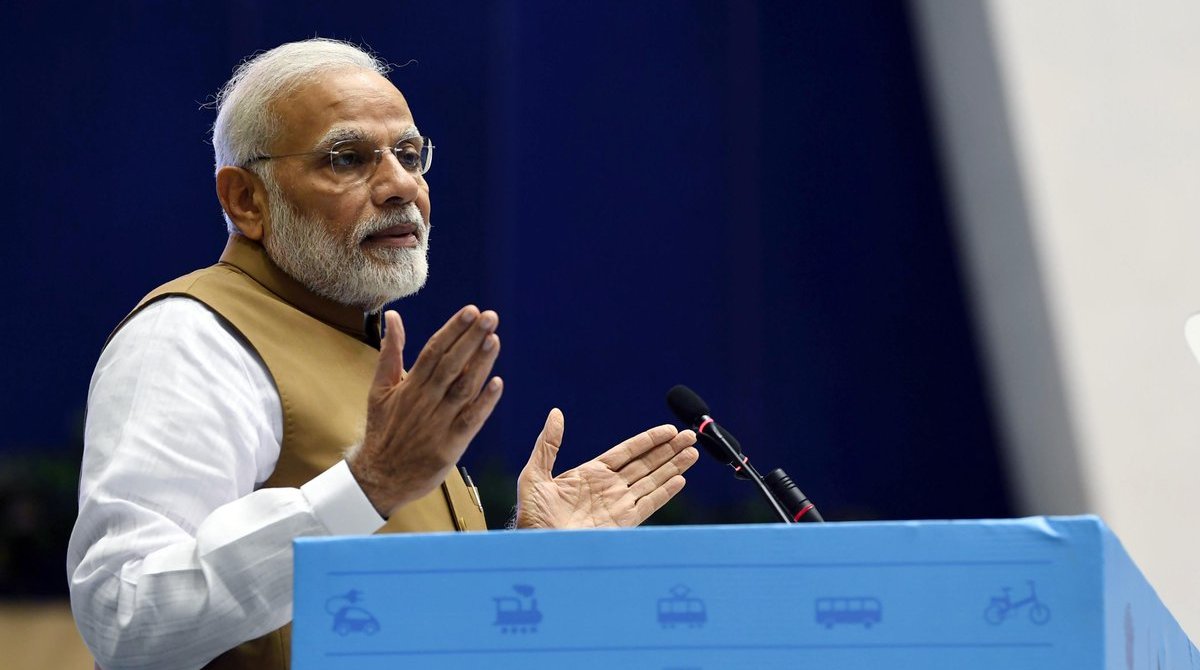Congress committing dacoity on rights of OBCs, SCs, STs: PM
“Wherever it (Congress) can do it, it will try to loot the claims of the SCs, STs and OBCs and give them to others,” said Modi.
“Clean mobility powered by clean energy is our most powerful weapon in our fight against climate change,” said the PM.

(Photo: Twitter/@PIB_India)
Prime Minister Narendra Modi on Friday said that India has displayed tremendous upwards mobility while highlighting the key areas such as infrastructure, economic reforms, standard of living, and start-ups led by the youth of the country. Speaking at the ‘Global Mobility Summit’ in New Delhi, the PM also revealed his government’s plan for making India a driver in electric vehicles.
At the event in which a number of industry leaders, including Suzuki Motor Corporation Chairman Osamu Suzuki, participated, the PM announced that his government would soon put in place a new policy to promote the use of electric vehicles in the country and fight against climate change.
“We want to build India as a driver in electric vehicles. We will soon put in place a stable policy regime around electric and other automated vehicles,” he said.
Advertisement
“We are promoting fuel efficient and cleaner fuel vehicles. We have developed low-cost air connectivity in under-served regions,” he added.
Identifying charged mobility as “the way forward”, the PM said, “We want to drive investments across the value chain from batteries to smart charging to electric vehicle manufacturing. India’s entrepreneurs and manufacturers are now poised to develop and deploy break-through battery technology.”
“Clean mobility powered by clean energy is our most powerful weapon in our fight against climate change. This means a pollution-free clean drive, leading to clean air and better living standards for our people. We should champion the idea of ‘clean kilometres’,” PM Modi added.
Underlining India’s growth, the PM said that “India is indeed on the move”.
“We are the world’s fastest growing major economy. We are building 100 smart cities. We are speedily building roads, airports, rail lines and ports,” said the PM.
“GST has helped us rationalise supply chains and warehouse networks. Our reforms are on the move. We have made India an easier place to do business. Families are getting homes, toilets, LPG cylinders, bank accounts & loans,” the PM said.
“We are fast emerging as the start-up hub of the world. India is moving ahead with new energy, urgency and purpose,” he said.
Recognising mobility as a key driver of the economy, the PM said that better mobility helps reduce the burden of travel and transportation, can boost economic growth and can create the next generation of jobs.
“My vision for the future of mobility in India is based on 7 C’s: Common, Connected, Convenient, Congestion-free, Charged, Clean, and Cutting-edge,” he said.
The PM said that the focus should also go beyond cars, to other vehicles such as scooters and rickshaws to make Common Public Transport the cornerstone of India’s mobility initiatives.
“Connected mobility implies integration of geographies as well as modes of transport. The Internet-enabled Connected Sharing Economy is emerging as the fulcrum of mobility. We must leverage the full potential for vehicle pooling to improve private vehicle utilisation,” he said.
The PM laid emphasis on safe, affordable and accessible mobility for all sections of the society including the elderly, the women and the specially-abled.
“Congestion free mobility is critical to check the economic and environmental costs of congestion. Hence, there should be emphasis on de-bottlenecking of networks. This would result in fewer traffic jams and lower levels of stress for commuters,” he said.
The PM told the gathering that his government has doubled the pace of construction of highways and re-energised the rural road building programme.
At the event, the PM laid out his vision for the future of mobility in India. He also released a report ‘Transforming India’s Mobility: A Perspective’ and visited the ‘Virtual Digital Exhibition’ at the Summit.
Advertisement